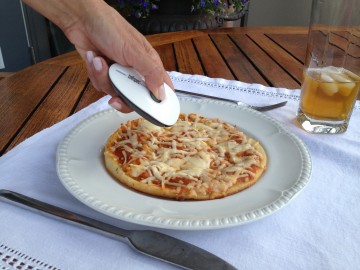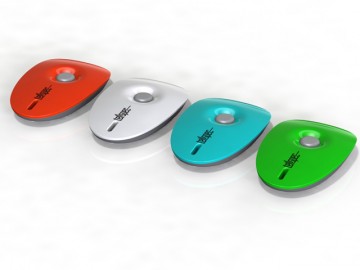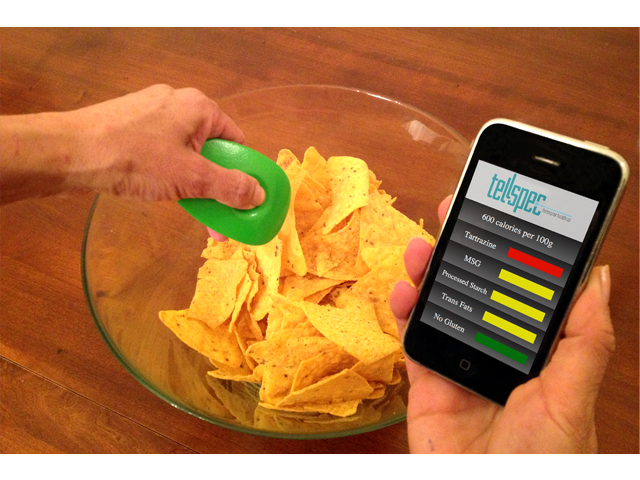There is no doubt that gluten and other food sensitivities, especially amongst children, are on the rise. We are all in-tuned to the food sensitivities even on a daily basis like at birthday parties. I’ve noticed in the past couple years that not-only do we have peanut-related allergies to accommodate but gluten as well.
Recently, I had this conversation with a friend of mine and an inventor’s name came up. Isabel Hoffmann is a working mother of two who has built eight companies on three continents over the last twenty years. Most recently Isabel had been working in the field of preventative medicine until her daughter became ill. Isabel took time off and after a year of exploring every possibility with many specialists and discovered that her daughter was very sensitive gluten and other allergens.
Isabel is now CEO of TellSpec, a biotech company to support the clean food revolution. With her partner, Professor Stephen Watson, TellSpec has developed the world’s first system that harnesses the science of spectroscopy, nano-photonics, and mathematical algorithms to detect nutrients, additives, allergens and even toxins in food products. You just aim your TellSpec scanner at the food, a cloud-based algorithm analyzes the findings in the food, and sends a report to your smart phone. It also tracks calories and identifies sensitivities & toxins. It spots potentially harmful ingredients like tartrazine (aka Food Yellow 4), gluten and trans fats (which are often not properly indicated on food labels) and empowers the user with the affordable power & technology to know what the ingredients are in their food BEFORE it is consumed.
“The invention exists and we are working towards our goal of bringing this technology to people everywhere worldwide – I need it, my family needs it, we all can benefit from it.”
I had the opportunity to interview Isabel Hoffman on the status of TellSpec and what’s needed to get this device into the hands of the consumer.
Your daughter has gluten sensitivities and there are growing number of kids, as well as adults, who are showing increased sensitivities as well. How difficult is it currently for you to go out to a restaurant to eat? (An example experience?)
 Hoffmann: Food sensitivities are becoming more common these days. There is a heightened awareness of ingredients such as sodium, trans fats, gluten, cholesterol. It is sometimes tricky to detect allergens or chemicals and the facts on labels can be misleading. Because my daughter has such severe reactions to allergens, it is very difficult for us to eat out in restaurants, and even at other people’s homes because it means we must rely on other people’s assurance that the food has no gluten. We are of Brazilian descent and we love going to Brazilian restaurants, especially “rodizio” grills. One day I took my daughter to my favorite Brazilian restaurant in Toronto and we explained her allergies to the waitress. Being cautious and safe, my daughter ended up eating only the grilled meats. At the end, she fancied some roasted pineapple, so she had some. In fact she had several portions of this delicious roasted pineapple. On the way home she started to itch and suddenly she was filled with rashes and hives all over her body. I called the restaurant and asked if they put wheat or gluten in their meat and they told me that they did not. Then I asked if they had gluten in the pineapple, and they answered, “No, the pineapple only has icing sugar.” Well, icing sugar, also known as power sugar, often has wheat added to it! They did not know this fact and I was wrong to assume they did. No more roasted pineapple for us!
Hoffmann: Food sensitivities are becoming more common these days. There is a heightened awareness of ingredients such as sodium, trans fats, gluten, cholesterol. It is sometimes tricky to detect allergens or chemicals and the facts on labels can be misleading. Because my daughter has such severe reactions to allergens, it is very difficult for us to eat out in restaurants, and even at other people’s homes because it means we must rely on other people’s assurance that the food has no gluten. We are of Brazilian descent and we love going to Brazilian restaurants, especially “rodizio” grills. One day I took my daughter to my favorite Brazilian restaurant in Toronto and we explained her allergies to the waitress. Being cautious and safe, my daughter ended up eating only the grilled meats. At the end, she fancied some roasted pineapple, so she had some. In fact she had several portions of this delicious roasted pineapple. On the way home she started to itch and suddenly she was filled with rashes and hives all over her body. I called the restaurant and asked if they put wheat or gluten in their meat and they told me that they did not. Then I asked if they had gluten in the pineapple, and they answered, “No, the pineapple only has icing sugar.” Well, icing sugar, also known as power sugar, often has wheat added to it! They did not know this fact and I was wrong to assume they did. No more roasted pineapple for us!
How long did it take to create the prototype and what challenges do you face?
Hoffmann: My daughter was sick for over a year and during that time we looked high and low for solutions. When we realized that it was an allergy, my partner, Stephen Watson, and I began using our math brains to figure out how to determine the ingredients in food so as to avoid allergens. It took us a little over nine months to develop a prototype TellSpec system which has three parts – a laser spectroscopy scanner, an algorithm to analyze the data, and a reporting function to send the data to your smartphone. Miniature Raman spectrometers are already available on the market from several companies and nanophotonics is making them smaller all the time. Our main focus was on developing the unique mathematical algorithm that could analyze the foods. We tested the accuracy of our scans using 3,000 foods and three existing models of spectrometers. The main innovation was in developing and coding the unique mathematical algorithm to analyze the information and identify ingredients; this alone took us seven months. Now one of our challenges is to raise capital to manufacture a smaller unit that is handheld and convenient, but has enough signal strength and resolution for our algorithm. We have launched a campaign on Indiegogo to allow people to participate and help us with the next phase of bringing TellSpec to market. (http://www.indiegogo.com/projects/tellspec-what-s-in-your-food)
 The prototype is currently able to read and break down toxins and allergens in the food we are about to consume. What else will be it be able to do (at the consumer level that people can understand)?
The prototype is currently able to read and break down toxins and allergens in the food we are about to consume. What else will be it be able to do (at the consumer level that people can understand)?
Hoffmann: This invention is the first of its kind and will give consumers the power to make an informed choice about what to buy or what to eat before consuming any food. TellSpec will be useful in a wide array of applications because today there are more reasons than ever for people to be aware of and care about the integrity of their food. TellSpec will be able to identify ingredients which may not be accurately reported and give consumers information about the ingredients in foods. When you see a reading for a mysterious ingredient, such as tartrazine, you can click on it and find out more relevant information such as description, any countries which restrict levels of the ingredient, etc. Besides being a powerful tool for awareness and identification, TellSpec has many tracking applications. Like programs which track your fitness activities, TellSpec will be able to track your intake of vitamins, nutrients and calories to ensure you are getting nutrition within your daily targets. You will also be able to use it to track symptoms experienced after eating so that you can correlate trends and patterns which may reveal food sensitivities. You will also be able to monitor your long-term intake of cumulative toxic chemicals, such as mercury. These are some of the planned features for Tellspec‘s launch. We have also received an enthusiastic response from many developers and healthcare practitioners who have other ideas about harnessing the power of TellSpec for various applications.
It’s meant to give you a “read” on various levels, but you still need to decide for yourself, as a consumer, what is acceptable for your own personal needs. Can you give an example of a toxin that is commonly found in a food and will the reader give various warning levels.
Hoffmann: TellSpec will generate the data and people can apply and use the data for their specific dietary preferences. TellSpec users will be able to learn, for example, about the presence of Tartrazine, a toxic ingredient which colours food yellow. When it’s in food, tartrazine is typically labelled as “colour”, “tartrazine”, or “E102”, depending on the jurisdiction, and the applicable labeling laws. In Canada, food manufacturers have the choice of declaring added colour(s) by either their common name or simply as “colour”. In other countries, such as Norway, Austria and Germany, tartrazine was banned. That is why we say TellSpec users will be able to go beyond the label to find out what’s really in their food. We will not be recommending levels of consumption at our launch phase, but that is something to consider in the future as we align with healthcare practitioners and developers to expand the applications of TellSpec.
Will you be able to somehow use this device to figure out the reports before ordering food? I see this as more of an awareness device – rather than something you will use after ordering simply because, as parents, you wouldn’t want to re-order and wait for food for your kids, or for yourself — or turn away food that is already prepared.
You are what you eat, so what exactly are you eating? Do you know?
Hoffmann: We are developing a handheld scanner and a cloud analysis engine that work together to gather the spectrum of your food, analyze that spectrum, and display information about the food on your smartphone. There are a few applications of TellSpec which relate to this question. First, wouldn’t it be nice if chefs had TellSpec in their kitchens and could ensure the integrity of their dishes before preparing the food. Second, yes, TellSpec is an awareness device but it also is a tracking device which collects data about a person’s food consumption over time and helps them to stay below desired limits of toxic chemicals. For instance, when you look and see you have ingested x amount of mercury, you may choose to have turf instead of surf for your next few meals. Third, if you do not know the source of symptoms you are experiencing, such as headaches, bloating, hives, etc., TellSpec can help you with its tracking capabilities to identify a possible correlation between food intake and your symptoms. Finally, TellSpec accumulates and amalgamates all the data retrieved from each and every scan so the analysis algorithm gets smarter over time by learning from the information that is being collected. This means that we will be able to find new uses for TellSpec the longer it is in use.
How much money do you think is needed to get this prototype into a compact and consumer friendly device and what’s your timing like?
Hoffmann: A key challenge is making the prototype smaller and less expensive so that it is convenient and affordable. We have launched a campaign on Indiegogo to raise $100,000 in order to manufacture TellSpec as a handheld unit and to develop the algorithm in the cloud. The early bird special is $150 for one TellSpec unit and includes two years of scan analysis.
Who else would this device be good for?
Hoffmann: You are what you eat, so what exactly are you eating? Do you know? Is there gluten in your food? Trans fats? Tartrazine? Is your food contributing to your headaches, rashes, sore stomach, weight gain? There are many loopholes in labels and ingredient lists so how do you find out the facts about the real ingredients in your food? Are you part of the “organic food” movement? TellSpec would be good for anyone who wants to eat healthy. People who are interested in weight loss, bodybuilding, allergens, anti-aging, and/or other reasons will be able to incorporate TellSpec into their healthcare regime with their doctor, naturopath, personal trainer or dietician. We are committed to building a healthier world by empowering individuals to make informed personal choices about what they eat and drink. TellSpec is part of the clean food revolution and we hope you’ll join us in making this important innovation a reality.
For more information visit the TellSpec Indiegogo page here at indiegogo.com
This post is not sponsored, nor was I compensated. Thanks to Isabel Hoffmann for taking the time to explain this device and sharing her experience as a mom and inventor.

Cool, huh? Wow…
I NEED one of these!!